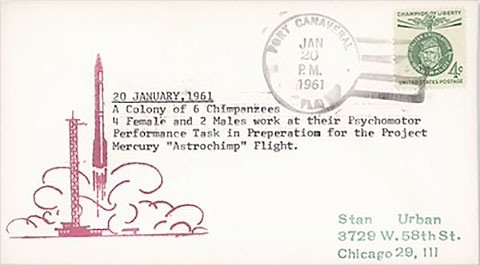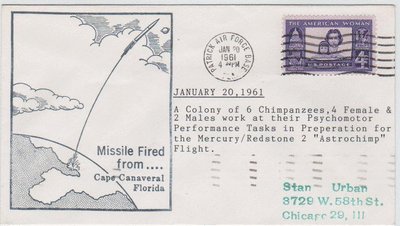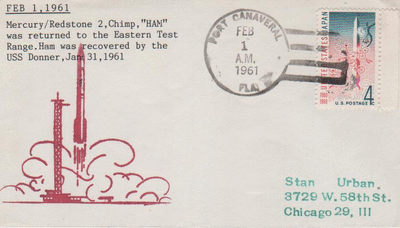Space Cover 605: Chimp-onautsThe “Chimp-onaut” project began at Holloman AFB in 1958 to use chimpanzees to test the life support systems of Mercury spacecraft as well as document the effects of spaceflight on them during and after their flights.
The 6571st Aeromedical Research Laboratory based at Holloman AFB, New Mexico was assigned the responsibility to train 65 chimpanzees, prepare them for spaceflight, and handle them after splashdown.
The space chimps began their training in the spring of 1959, at the same time as Mercury astronauts.
The chimps were taught to wear fitted space suits and to tolerate being strapped for long periods on padded contour couches. The chimps were also flown in aircraft used for aeronautic stunts to get them accustomed to sudden noise, vibration and G forces, and for them to learn what weightlessness felt like.
The chimps were trained by instrumental conditioning, a method of learning that employs rewards and punishments for behavior. Using control panels in their trainers, equipped with two levers and two lights, the chimp’s task was to pull the right-hand lever when the white light came on and the left lever when the blue light came on. If the chimp pulled the correct lever, a banana-flavored pellet was dispensed as a reward. If the chip responded incorrectly, the chimp received a mild electric shock to the bottoms of their feet. How well the chimps worked the levers while in space was an experiment to test an astronaut’s capability to perform and operate in space under conditions of weightlessness and high G forces.
After training chimps and humans on the trainers, it turns out, when compared, the chimpanzees were more skillful than humans in working with the lights and levers. One female chimp even learned to work the levers with her feet so that it kept her hands free to grab the reward pellets faster.
In January 1961, six chimps (four females, two males) and their handlers moved from Holloman AFB to Cape Canaveral and into a compound behind “Hangar S.” The chimps continued working out on their mockup Mercury capsule trainers. The first mission would be days away on January 31st.
At the top of this post is an image of a cover for January 20, 1961 for the Titan launch from Cape Canaveral which was a Mk 4 re-entry vehicle test. The cover has a Swanson RSC but had no other markings to indicate that it was for the Titan launch so Stan Urban changed the Titan cover to a Chimp-onaut cover by typing the information on the cover about the chimp colony training at Cape Canaveral for the upcoming flight.
It was not until the night before the flight that Project Mercury officials chose a male chimpanzee named Chop Chop Chang (Ham) to fly the mission and picked a female chimpanzee named Minnie as his backup. Ham was born in Cameroon in West Africa in July 1957 and was brought to Holloman AFB in 1959.
Ham’s mission, Mercury-Redstone 2, launched from Cape Canaveral down the Atlantic Test Range. Upon splashdown the first ship on the scene was the USS Ellison with the recovery by the prime recovery ship USS Donner. Ham returned to Cape Canaveral as a candidate for the second chimp mission into space, Mercury-Atlas 5, on November 29th.
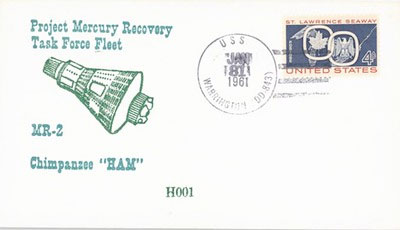
Here is a cover created by Rich Hoffner, who sent 63 covers to the USS Warrington, a secondary recovery ship for the mission.
The chimp-onaut for the second mission was Enos, who was regarded as the quickest and brightest member of the whole chimp colony. Like Ham, Enos was born in Cameroon. Enos arrived at Holloman AFB in April 1960.
Enos’ mission would be more complex than the one Ham flew, so his training was more intensive. Enos performed 1,263 hours of training, 343 of them in the Mercury capsule simulator. At 10:07 a.m. on November 29, the Atlas missile booster lifted Enos and the Mercury capsule from Cape Canaveral for what was intended to be three orbits of the Earth.
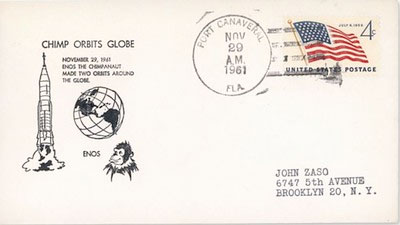
Here is a Zaso printed cachet for the Enos launch.
Enos performed exceptionally, as shortly into the flight, the lever for the motor skills testing malfunctioned. No matter how Enos performed his tasks, Enos got a shock to the bottoms of his feet. That did not stop him at all, Enos continued to pull his levers correctly.
The mission was terminated after two orbits, as the result of an attitude control system malfunction. The capsule splashed down off Puerto Rico following a flight of three hours and 21 minutes with recovery by the USS Stormes.
Enos’ flight was the trial run for John Glenn’s Friendship 7 orbital flight on February 20, 1962. When Glenn later met the President’s four-year-old daughter, Caroline Kennedy, in Washington, her first question was, “Where’s the monkey?” and this was commemorated on a Project Mercury FDC by Carl Swanson of Space Craft Covers. This is one of the most sought-after Project Mercury FDCs.
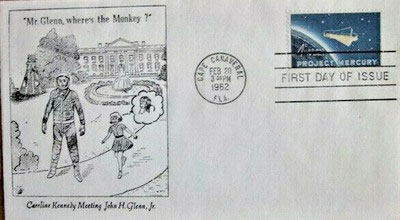
Data recorded from the missions found that pulse and respiration rates and blood pressures for Ham and Enos were unexceptional during their flights and that performance of their tasks was unaffected by the weightless state.











